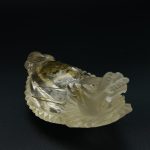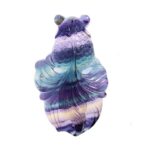Quartz crystals are one of the most common and versatile minerals on Earth. They are used in a wide variety of applications, from jewelry to electronics. But how are these crystals formed?

The Basics of Crystal Formation
Crystals are formed when atoms or molecules arrange themselves in a regular, repeating pattern. This process can occur in a variety of ways, but the most common method is through precipitation. Precipitation occurs when a solution becomes supersaturated, meaning that it contains more dissolved material than it can hold. When this happens, the excess material precipitates out of the solution and forms crystals.
Quartz Crystal Formation
Quartz crystals are formed when silica-rich water cools and crystallizes. Silica is a compound made up of silicon and oxygen atoms. When silica-rich water cools, the silica atoms start to come together and form crystals. The shape of the crystals depends on the temperature and pressure of the water.
At low temperatures and pressures, quartz crystals form as hexagonal prisms. These crystals are typically clear or white and have a glassy luster. As the temperature and pressure increase, quartz crystals start to form as bipyramids. Bipyramids are crystals with two pyramids that are joined at their bases. These crystals are typically milky white or gray and have a dull luster.
Where Are Quartz Crystals Found?
Quartz crystals are found all over the world. They are most commonly found in igneous and metamorphic rocks. Igneous rocks are formed when magma cools and crystallizes. Metamorphic rocks are formed when existing rocks are changed by heat, pressure, or chemical reactions.
Uses of Quartz Crystals
Quartz crystals have a wide variety of uses. Some of the most common uses include:
- Jewelry: Quartz crystals are often used in jewelry because they are beautiful and durable.
- Electronics: Quartz crystals are used in a variety of electronic devices, such as watches, clocks, and computers.
- Medicine: Quartz crystals are used in some medical applications, such as healing and pain relief.
- Industry: Quartz crystals are used in a variety of industrial applications, such as cutting tools and abrasives.
The Future of Quartz Crystals
Quartz crystals are a versatile and important mineral with a wide range of applications. As technology continues to develop, new uses for quartz crystals are likely to be found.
Key Statistics
- Quartz is the second most abundant mineral in the Earth’s crust, after feldspar.
- Quartz crystals can grow to be very large. The largest quartz crystal ever found was over 10 feet long and weighed over 100 tons.
- Quartz crystals have a variety of colors, including clear, white, pink, purple, and yellow.
- Quartz crystals are used in a wide variety of applications, including jewelry, electronics, medicine, and industry.
Creative New Word: Crystallize
Crystallize is a new word that can be used to describe the process of forming crystals. This word can be used in a variety of contexts, such as:
- The water in the lake crystallized into beautiful ice crystals.
- The salt in the soup crystallized and formed a crust on the surface.
- The ideas in my head crystallized into a plan.
Useful Tables
| Property | Value |
|---|---|
| Chemical formula | SiO2 |
| Crystal structure | Hexagonal |
| Hardness | 7 |
| Density | 2.65 g/cm3 |
| Melting point | 1713 °C |
| Boiling point | 2230 °C |
| Color | Occurrence |
|---|---|
| Clear | Most common |
| White | Second most common |
| Pink | Rose quartz |
| Purple | Amethyst |
| Yellow | Citrine |
| Application | Description |
|---|---|
| Jewelry | Used in a variety of jewelry, such as rings, necklaces, and earrings. |
| Electronics | Used in a variety of electronic devices, such as watches, clocks, and computers. |
| Medicine | Used in some medical applications, such as healing and pain relief. |
| Industry | Used in a variety of industrial applications, such as cutting tools and abrasives. |
Step-by-Step Approach to Crystallizing a Solution
- Dissolve a substance in a solvent until the solution is supersaturated.
- Place the solution in a clean container.
- Cover the container and let it sit undisturbed for several days or weeks.
- Crystals will start to form on the sides and bottom of the container.
- Once the crystals have grown to the desired size, remove them from the solution and dry them.
Why Quartz Crystals Matter
Quartz crystals are an important mineral with a wide range of applications. They are used in jewelry, electronics, medicine, and industry. As technology continues to develop, new uses for quartz crystals are likely to be found.
Benefits of Quartz Crystals
Quartz crystals have a variety of benefits, including:
- They are beautiful and durable.
- They are used in a variety of electronic devices.
- They have some medical applications.
- They are used in a variety of industrial applications.




























